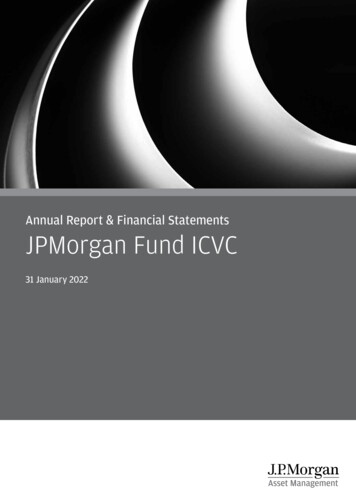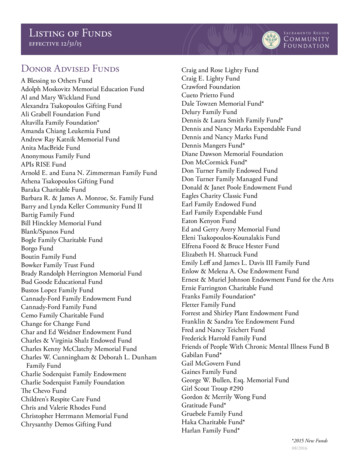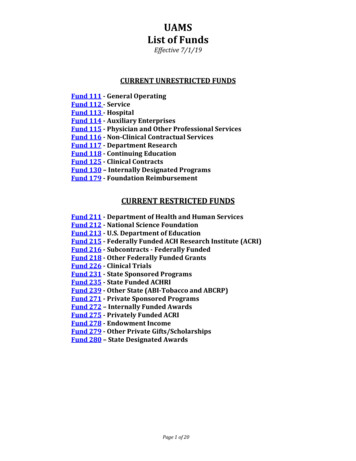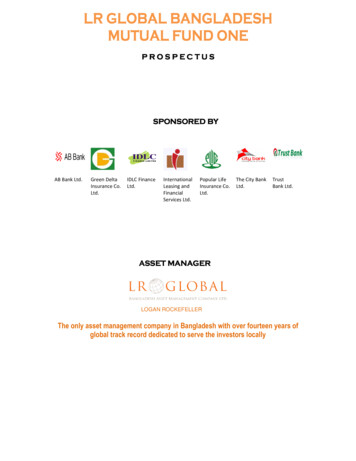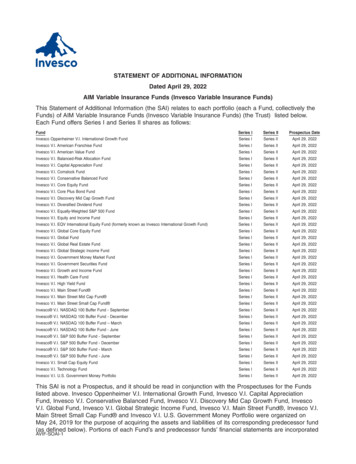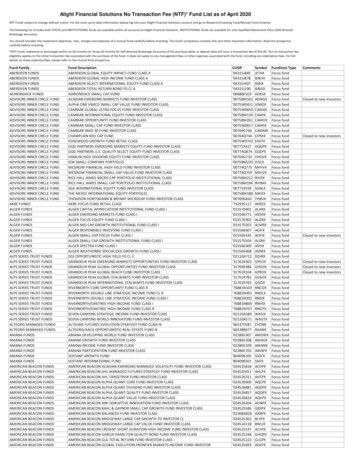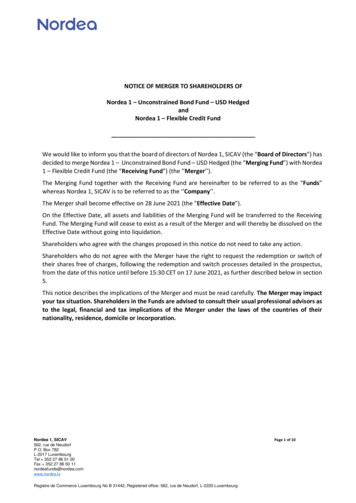
Transcription
What do fund flows reveal about asset pricing models and investor sophistication?Narasimhan Jegadeesh and Chandra Sekhar Mangipudi Goizueta Business SchoolEmory UniversityJanuary, 2019 Narasimhan Jegadeesh is the Dean’s Distinguished Professor at the Goizueta Business School,Emory University, Atlanta, GA 30322, ph: 404-727-4821, email: Jegadeesh@emory.edu.,Chandra Sekhar Mangipudi is a Doctoral student at Emory University, email:chandra.sekhar.mangipudi@emory.edu . We would like to thank Jonathan Berk, Kent Daniel,Amit Goyal, Cliff Green, Jay Shanken, and the seminar participants at the 2018 SFS CavalcadeNorth America, Louisiana State University and Virginia Tech for helpful discussions, comments,and suggestions.
What do fund flows reveal about asset pricing models and investor sophistication?Recent literature uses the relative strength of the relation between fund flows and alphaswith respect to various multifactor models to draw inferences about the best asset pricing modeland about investor sophistication. This paper analytically shows that such inferences are tenableonly under certain assumptions and we test their empirical validity. Our results indicate that anyinference about the true asset pricing model based on alpha-flow relations is empirically untenable.The literature uses a multifactor model that includes all factors as the benchmark to assess investorsophistication. We show that the appropriate benchmark excludes some factors when their betasare estimated from the data, but even with this benchmark the rejection of investor sophisticationin the literature is empirically tenable.
An extensive literature documents that net fund flows into mutual funds are driven byfunds’ past performance. For example, Patel, Zeckhauser, and Hendricks (1994) document thatequity mutual funds with bigger returns attract more cash inflows and they offer various behavioralexplanations for this phenomenon. Other papers that document a positive relation between fundflows and past performance include Ippolito (1992), Chevalier and Ellison (1997), and Sirri andTufano (1998).Some papers in the early literature also examine whether abnormal performance (or alphas)measured with respect to some benchmarks better predict fund flows than others. For example,Gruber (1996) compares the mutual fund flow-performance relation for alphas measured withrespect to one- and four-factor models, while Del Guercio and Tkac (2002) compares sensitivityof flows to raw returns vis-à-vis alphas from market model in mutual funds and pension funds.Fung et. al. (2008) makes similar comparisons with a different set of factor models for a sampleof hedge funds.While comparison of flow-alpha relations across models was not the primary focus ofearlier papers, recent papers in this area have shown a renewed interest in such comparisons usinga broader range of asset pricing and factor models. The primary driving force for this resurgenceis the argument that these comparisons can potentially help us answer important economicquestions that extend beyond a descriptive analysis of mutual fund flows. For example, Barber,Huang and Odean (2016) (hereafter “BHO”) compare the relation between fund flows and alphasmeasured with respect to various models to evaluate mutual fund investors’ sophistication. Theyargue that sophisticated investors should use all common factors to compute alphas and evaluatefund performance regardless of the underlying true asset pricing model. BHO find that fund flowsare more highly correlated with market model alphas than with other alphas. Because investorsdo not seem to be using alphas with respect to a model that includes all common factors, BHOconclude that investors in aggregate are not sophisticated in how they use past returns to assessfund performance.Berk and van Binsbergen (2016) (hereafter “BvB”) argue that such comparisons serve as anew and fundamentally different test of asset pricing models and that the results can determinewhich asset pricing model is the closest to the true asset pricing model in the economy. Becauseof the asset pricing model implications, they include several versions of equilibrium consumption1
CAPM as well in their comparisons. Agarwal, Green and Ren (2017) and Blocher and Molyboga(2017) carry out similar tests with samples of hedge funds.BvB find that fund flows are most highly correlated with alphas computed with a marketmodel in their tests as well. They conclude that therefore the CAPM “is still the best method touse to compute the cost of capital of an investment opportunity.” Berk and van Binsbergen (2017)also prescribe that practitioners should use the CAPM to make capital budgeting decisions basedon this evidence. The true asset pricing model has been a holy grail of the finance literature andBvB’s conclusions potentially have broad implications that go well beyond just the mutual fundliterature.The far reaching inferences drawn in the recent literature based on comparisons of flowalpha relations stand in contrast with the much more limited inferences drawn in the earlyliterature. A natural question that arises is, under what assumptions can one draw reliableinferences about asset pricing models or about investor sophistication based on these results? Arethe inferences about asset pricing models and investor sophistication in the recent literatureempirically tenable?We address these questions in this paper. We analytically show that one can draw reliableinferences about the true asset pricing model based on flow-alpha relations only if certain criticallyimportant assumptions are valid, and their validity can only be empirically determined. Forexample, it is possible that in some situations CAPM may not be true but investors may stilloptimally use the market model to estimate alphas. Also, in some other situations, it is possiblethat CAPM may be true but investors may optimally use a multifactor model to estimate alphas.There are also situations where investors may optimally use the market model to estimate alphawhen CAPM is true, which would justify inferences about asset pricing model. Therefore, onecannot identify the true asset pricing model solely based on flow-alpha comparison without furthertests to determine which of these multiple possibilities are true in the data.We find similar issues with drawing inferences about investor sophistication as well.Sophisticated investors would use the model that yields the most precise alpha estimates. We showthat the optimal model depends on the following factors: the underlying true asset pricing model,the incremental explanatory power of each factor in a multifactor model, the dispersion of factorbetas across funds and the potential error in estimating factor betas. Our results indicate that this2
optimal model need not be the true asset pricing model, nor does it need to use all common factorsto estimate betas. Therefore, the optimal model can only be empirically identified and we need theidentity of this model to draw reliable inferences about investor sophistication based on flow-alpharelations.We empirically assess whether inferences about asset pricing models and investorsophistication based on flow-alpha relations are tenable. Our tests estimate the relevant parametersfrom the data and run simulation experiments under various “true” asset pricing models. Thesetests enable us to determine the multifactor model that provides the most precise estimator ofalphas in the data and assess the tenability of the inferences about asset pricing and investorsophistication in the literature.1. Fund flows and alphas: Foundation for empirical tests and inferencesThis section presents a model that forms the basis for our analysis of the implications of flowalpha relations for asset pricing models and tests of investor sophistication. Broadly, we use themodel to answer the following questions:(a) How do investors optimally update their priors about the skills of fund managers when theyobserve fund returns each period?(b) How are equilibrium fund flows related to the information investors use to update theirpriors?(c) What are the implications of the answers to the above questions for interpreting the resultsof an alpha-fund flow horse race with alphas computed using different multifactor models?We answer these questions using the Berk and Green (2004) model augmented with amultifactor return generating process and an equilibrium asset pricing model that we describe inthe next subsection.1.1 Return generating process and asset pricing modelThe following K-factor model is the true asset pricing model:𝐾𝐸[𝑟𝑖 ] 𝛽𝑘,𝑖 𝛾𝑘 ,(1)𝑘 13
where 𝑟𝑖 is the return in excess of the risk-free rate, or excess returns, 𝐸[𝑟𝑖 ] is the expected excessreturn on asset i, 𝛽𝑘,𝑖 is the beta of asset i with respect to factor k, and 𝛾𝑘 is the premium for a unitof factor risk. For the CAPM, 𝐾 1 and for Fama-French three-factor model, which we refer toas FF3, 𝐾 3.Asset returns follow the J-factor model below:1𝐽𝑟𝑖,𝑡 𝐸[𝑟𝑖 ] 𝛽𝑘,𝑖 𝑓𝑘,𝑡 𝜉𝑖,𝑡 ,(2)𝑘 1where 𝑓𝑘,𝑡 is the realization of the common factor k, and 𝜉𝑖,𝑡 asset specific return at time t. Factorrealization 𝑓𝑘,𝑡 is the innovation or the unexpected component of factor k. For instance, let 𝐹𝑘,𝑡 bethe total factor realization of the kth factor, then 𝑓𝑘,𝑡 𝐹𝑘,𝑡 𝐸[𝐹𝑘,𝑡 ] and 𝐸[𝑓𝑘,𝑡 ] 0. We definea “no-beta risk premium” (NBRP) model where 𝐸[𝑟𝑖 ] 𝐸[𝑟𝑚 ], and we identify this model with𝐾 0.In general the 𝐽 factors in the multifactor model (3) include the 𝐾 priced factors from theasset pricing model as well as additional unpriced factors that describe realized returns but areexcluded from the asset pricing model. For example, the 𝐽 factors could include industry factorsthat are unpriced perhaps because they are not correlated with future investment opportunity set orto consumption. Therefore, in general 𝐽 𝐾. Factor returns and asset specific returns are allnormally distributed.1.2 The ModelThis subsection presents a rational expectations model that identifies the alphas thatinvestors use to make their mutual fund investment decision. The following are our assumptions:(a) Rational Economy: All agents in the rational expectations economy are symmetricallyinformed.(b) Mutual funds and skill: There are N mutual funds in the economy and 𝑁 . Managerof fund p is endowed with stock selection skills that allow them to generate gross returns1Eq. 3 imposes the condition that the intercept of the return generating process for each asset equals its expectedreturn.4
of 𝜙𝑝 in excess of the K-factor asset pricing benchmark. Investors know the true assetpricing model. Fund manager skill 𝜙𝑝 𝑁(𝜙0 , 𝜈), where 𝜙0 is average skill and 𝜈 is theprecision of the distribution of skill at time 0. 𝜙0 and 𝜈 are common knowledge.(c) Costs of active management: Funds incur certain costs for active management, which isa function of total assets under management, denoted as 𝑞, and 𝑐(𝑞) is this cost per unitof assets. The cost 𝑐(𝑞) includes both fund fees and the costs of administration and tradingincluding administrative costs, brokerage costs and price impact. There are diseconomiesof scale and hence 𝑐(𝑞) is an increasing function of q. The only further assumption that weimpose on 𝑐(𝑞) is that lim 𝑐(𝑞) , which ensures that the size of a mutual fund for any𝑞 skill level is finite.(d) Gross and net returns: Let 𝑅𝑝,𝑡 and 𝑟𝑝,𝑡 be fund p’s gross and net returns at time t,respectively. 𝑅𝑝,𝑡 𝑟𝑝,𝑡 𝑐(𝑞𝑝.𝑡 1 ). Funds’ net returns are observable, both to investors inthe model economy and to econometricians. Investors can also compute 𝑅𝑝,𝑡 since theyknow q and 𝑐(𝑞) but econometricians observe only 𝑟𝑝,𝑡 .(e) Expected return and return generating process: Eqs. (1) and (2) specify the expectedreturns and the return generating process in this economy, which are both commonknowledge. The net return at time t is:2𝐽𝐾𝑟𝑝,𝑡 𝜙𝑝 𝛽𝑘,𝑝 𝛾𝑘 𝑘 1Expected return Eq. (1) 𝛽𝑘,𝑝 𝑓𝑘,𝑡 𝜉𝑝,𝑡 𝑐(𝑞𝑝,𝑡 1 ), 𝑘 1(3)Unexpected return Eq. (2)From Eq. (3), expected abnormal return based on the true asset pricing model is:𝐾Et (𝑟𝑝,𝑡 1 ) 𝛽𝑘,𝑝 𝛾𝑘 Et (𝜙𝑝 ) 𝑐(𝑞𝑝,𝑡 ),(4)𝑘 1where 𝐸𝑡 denotes expectation as of time t.(f) Competitive Market: As in Berk and Green (2004), the mutual fund market is perfectlycompetitive. Therefore, expected alpha net of fees and costs for investing in any mutualfund equals zero in equilibrium:Funds’ gross returns follow the return generating process (2), plus 𝜙𝑝𝐾 . Investors earn net returns in (3) after allcosts.25
Et (𝜙𝑝 ) 𝑐(𝑞𝑝,𝑡 ) 0.(5)Assumptions (a) through (d) and (f) are the same as in Berk and Green (2004). We addassumption (e) about expected asset returns and return generating factor model to allow investorsthe option of computing alphas using different models and then determine which of these alphaswill win the alpha-flow horse race.In our model, investors observe mutual fund returns and the realized returns on the J factorseach period. For now, we assume 𝛽𝑘,𝑝 is common knowledge. Investors compute alphas, 𝛼̂𝑝,𝜂,𝑡 ,relative to an 𝜂-factor model, as:𝜂𝛼̂𝑝,𝜂,𝑡 𝑟𝑝,𝑡 𝛽𝑘,𝑝 𝐹𝑘,𝑡 ,(6)𝑘 1where 𝐹𝑘,𝑡 is realized factor returns.Investors could possibly use any 𝜂-factor model to compute alphas and update their priorsabout fund manager skills. Which particular model would they use? For analytic convenience, wefurther assume that the average factor betas of funds equal betas for the market portfolio. For themarket, 𝛽𝑘,𝑚𝑎𝑟𝑘𝑒𝑡 1 for 𝑘 market and 𝛽𝑘,𝑚𝑎𝑟𝑘𝑒𝑡 0 for 𝑘 market. With this assumption,the average mutual fund alpha estimated with any 𝜂 equals zero for any factor as we show in thefollowing proposition.3Lemma 1: Under the assumptions stated above the cross-sectional average of alphas estimatedusing any 𝜂-factor model equals zero for all factor realizations, i.e.1 𝑁𝑁(𝛼̂𝑝,𝜂,𝑡 𝐹 𝑘,𝑡 , 𝑘 1, , 𝐾) 0 𝜂.(7)𝑝 1Proof: Substitute 𝑟𝑝,𝑡 from Eq. (3) to Eq. (6) and use the competitive market condition (5) to get(7).3If the average factor betas for funds are different from market portfolio betas, we could subtract the average of alphafor all funds from 𝛼̂𝑝,𝜂,𝑡 and the average of this difference equals zero for any factor realization. Since investmentdecisions are made based on the relative values of alpha both approaches would yield the same result.6
The following proposition presents the distribution of investors’ posterior each period conditionalon using a particular 𝜂-factor model to compute alphas.Proposition 1: Suppose investors use an 𝜂-factor model to compute alphas. Let 𝜙𝑝,𝜂,𝑡 be the meanof investors’ time t posterior of fund k’s skill conditional on the realization of 𝑋𝑝,𝜂,1 , 𝑋𝑝,𝜂,2 , 𝑋𝑝,𝜂,𝑡 , where 𝑋𝑝,𝜂,𝑡 𝛼̂𝑝,𝜂,𝑡 𝑐(𝑞𝑝,𝑡 1 ), and let 𝑋̅𝑝,𝜂,𝑡 be the mean of these realizations.Investors’ posterior of 𝜙𝑝 is normally distributed with mean 𝜙𝑝,𝜂,𝑡 , where:𝜙𝑝,𝜂,𝑡 𝜈 𝜙0 𝑡𝜗𝛼̂,𝜂 𝑋̅𝑝,𝜂,𝑡,𝜈 𝑡𝜗𝛼̂,𝜂(8)1and precision 𝜈 𝑡𝜗𝛼̂,𝜂 , where 𝜗𝛼̂,𝜂 𝜎2 . Note that the precisions of 𝑋𝑝,𝜂,𝑡 and 𝛼̂𝑝,𝜂,𝑡 are equal̂ ,𝜂𝛼conditional on information available at time t-1 since 𝑐(𝑞𝑝,𝑡 1 ) is known at that time.Proof: See Theorem 1 in DeGroot (1970, p. 167).Proposition 1 is a well-known theorem in Bayesian analysis. Investors know that theaverage skill of fund managers is 𝜙0 at time 0. After observing net returns for t periods, investorscompute alphas for each period. As Lemma 1 shows, the mean of 𝛼̂𝑝,𝜂,𝑡 is zero each period.Investors also know the cost 𝑐(𝑞𝑡 1 ) each period and therefore they can compute 𝑋𝑝,𝜂,𝑡 . Becauseof the perfect competition assumption (5) the expected value of 𝑐(𝑞) in 𝑋̅ across all funds equals𝜙0 . But mean of both investors prior and posterior equal 𝜙0 as long as funds do not enter or exitthe sample.𝐾Proposition 1 shows that the precision of the posterior distribution of 𝜙𝑝,𝜂,𝑡increasesmonotonically with an increase in the precision of 𝛼̂𝑝,𝜂,𝑡 . Because rational investors prefer a moreprecise estimator to a less precise estimator, investors would use the multi factor model that yieldsthe most precise estimate of alphas.Corollary: Rational investors would use the 𝜂-factor model with the smallest variance (orlargest precision) to revise their priors about fund skills.We denote the number of factors in the factor this optimal model as 𝜂 .7
1.3 Alphas and fund flowsThe literature typically runs the following regression between alphas and fund flows todraw inferences about asset pricing model or investor sophistication:Γ𝑝,𝑡 𝑎𝜂 𝑏𝜂 𝛼̂𝑝,𝜂,𝑡 𝜔𝑝,𝜂,𝑡 ,(9)where 𝛼̂𝑝,𝜂,𝑡 is computed under various 𝜂-factor models in Eq. (6) and Γ𝑝,𝑡 is the net flow of fundsinto mutual fund 𝑝, defined as:Γ𝑝,𝑡 𝑞𝑝,𝑡 𝑞𝑝,𝑡 1 (1 𝑟𝑝,𝑡 )𝑞𝑝,𝑡 𝑞𝑝,𝑡 1 𝑟𝑝,𝑡 .𝑞𝑝,𝑡 1𝑞𝑝,𝑡 1(10)BvB, BHO and others in related literature run a horse race with the slope coefficient𝑏𝜂 from (9) and draw inferences about the true asset pricing models and investors sophisticationbased on the winner.4 This subsection derives fund flows in the model as a function of the alphainvestors use to update their priors and examines the tenability of such inferences.As we showed in the last subsection, investors update their priors each period using themost precise alpha estimator 𝛼̂𝑝,𝜂 ,𝑡 and decide on which funds they would invest in or divest fromeach period. The competitive market condition in Eq. (5) implies that in a competitive equilibriumthe flow results in 𝑞𝑝,𝑡 such that 𝑐(𝑞𝑡 ) equals 𝜙𝑝,𝜂 ,𝑡 . To determine the fund flow in thiscompetitive equilibrium, we use the following recursive equation for 𝑐(𝑞𝑡 ) that follows from Eq.(8) in Proposition 1:5𝑐(𝑞𝑡 ) 𝑐(𝑞𝑡 1 ) 𝜗𝛼̂,𝜂 𝛼̂𝑝,𝜂 ,𝑡 .𝜈 𝑡𝜗𝛼̂,𝜂 (11)4BvB use a regression that uses only the signs of Γ𝑝,𝑡 and 𝛼̂𝑝,𝜂,𝑡 . We show in a later section that BvB regression yieldsidentical inference as the linear regression (9).5Berk and Green (2004) derive this equation based on DeGroot’s (1970) theorem. Appendix 3 presents a derivationfor easy reference.8
To determine a functional relation between flow and alpha, we assume that the cost function isgiven by:𝑐(𝑞) 𝛿 𝑞,(12)where 𝛿 is a constant that is common knowledge. Using this cost function, from (10) and (11) weget:Γ𝑝,𝑡 𝜗𝛼̂,𝜂 1 𝛼̂𝑝,𝜂 ,𝑡 𝑟𝑝,𝑡 .𝛿 𝑞𝑡 1 𝜈 𝑡𝜗𝛼̂,𝜂 (13)Eq. (13) shows that flows are directly related to 𝛼̂𝑝,𝜂 ,𝑡 , the most precise estimate. As weshow later, the winner of the horse race also depends on the sign of the covariance between Γ𝑝,𝑡and 𝛼̂𝑝,𝜂 ,𝑡 . Intuitively, we expect that Covariance(Γ𝑝,𝑡 , 𝛼̂𝑝,𝜂 ,𝑡 ) 0 but we need to show that it isindeed positive in our model. The first term on the right-hand side of Eq. (13) shows that Γ𝑝,𝑡increases with 𝛼̂𝑝,𝜂 ,𝑡 because its coefficient is positive. However, because the second term equals𝜂 (𝛼̂𝑝,𝜂 ,𝑡 𝑘 1 𝛽 𝑘,𝑝 𝐹𝑘,𝑡 ) from Eq. (6), there is a negative relation between this term and Γ𝑝,𝑡 .The reason is that Γ𝑝,𝑡 is the flow net of changes in assets under management due to raw returnsand any change due to return has a negative impact on Γ𝑝,𝑡 . So it is mathematically possible thatthe net effect would be negative.As a first step, we examine the relation between Γ𝑝,𝑡 and 𝛼̂𝑝,𝜂 ,𝑡 . Differentiating (13), weget:6𝑑 Γ𝑝,𝑡𝜗𝛼̂,𝜂 1 1.̂ 𝑝,𝜂 ,𝑡 𝛿𝑞𝑡 1 𝜈 𝑡𝜗𝛼̂,𝜂 𝑑𝛼(14)Eq. (14) indicates that the slope is negative if:6We use the result that𝑑𝑟𝑝,𝑡̂ 𝑝,𝜂 ,𝑡𝑑𝛼 1 from (6).9
𝜗𝛼̂,𝜂 𝛿𝑞𝑡 1 .𝜈 𝑡𝜗𝛼̂,𝜂 (15)Eq. (11) shows that fund size would increase when 𝛼̂𝑝,𝜂 ,𝑡 0 because positive alpha leadsto upward revision of priors. When 𝛼̂𝑝,𝜂 ,𝑡 0, the fund size does not increase in equilibrium,which implies that Γ𝑝,𝑡 0 for 𝛼̂𝑝,𝜂 ,𝑡 0. So if𝑑Γ𝑝,𝑡̂ 𝑝,𝜂 ,𝑡𝑑𝛼 0, there would be negative flow inequilibrium when 𝛼̂𝑝,𝜂 ,𝑡 0.The right hand side of inequality (15) is the cost of active management per unit of fund.This condition indicates that if assets under management is sufficiently large, then because of theincremental cost of active management, investors would actually withdraw funds (or the mutualfund would voluntarily return funds) even if investors positively update their priors about fundmanager skills. Therefore, funds in this economy cannot grow beyond the critical size defined byEq. (15). Formally, from (15) the maximum size 𝑄 𝑚𝑎𝑥 for a fund in this economy is:𝑄 𝑚𝑎𝑥 𝜗𝛼̂,𝜂 1,𝛿 𝜈 𝑡𝜗𝛼̂,𝜂 (16)because beyond this point any increase in fund size, even if it is passively due to fund size, willresult in outflow of funds.7 Since the maximum fund size is given by (16), in this economy,𝑑Γ𝑝,𝑡𝑚𝑎𝑥 0 for 𝑞𝑡 𝑄.̂ 𝑝,𝜂 ,𝑡𝑑𝛼(17)Proposition 2 below formally states the results from our model that we will use to examinewhat we can learn from the horse race regressions.Proposition 2: The net flow of funds Γ𝑝,𝑡 in any period is only a function of alpha from the mostprecise estimator and not from other estimators. Also, in equilibrium:𝐶𝑜𝑣(𝛼̂𝑝,𝜂 ,𝑡 , Γ𝑝,𝑡 ) 0(18)7Historically, a few mutual funds have been closed to new investors evidently because they hit against the maximumassets under management condition and were not willing to accept additional assets. Several successful hedge fundsare also closed to new investors and a well-known example is Renaissance Technologies which returned all fundsfrom its outside investors by 2005 (https://en.wikipedia.org/wiki/Renaissance Technologies#Monemetrics).10
Proof: Eq. (13) proves the first part of the proposition. See Appendix 5 for proof of the secondpart.1.4 Alpha-fund flows horse raceThe literature fits regression (9) using estimates of 𝛼̂𝑝,𝜂,𝑡 from competing 𝜂-factor models andruns a horse race with the slope coefficient 𝑏̂𝜂 . What can we learn about the true asset pricingmodel or about investor sophistication based on this horse race?The slope coefficient estimate is:𝑝𝑙𝑖𝑚 𝑏𝜂 𝐶𝑜𝑣(Γ𝑝 , 𝛼̂𝑝,𝜂,𝑡 )𝜎𝛼̂2𝑝,𝜂,𝑡(19)where 𝜎𝛼̂2𝑝,𝜂,𝑡 is cross-sectional variance of 𝛼̂𝑝,𝜂,𝑡 . As Proposition 2 shows Γ𝑝 is a function of𝛼̂𝑝,𝜂 ,𝑡 and therefore any covariance of Γ𝑝 with other alphas is through their relations with 𝛼̂𝑝,𝜂 ,𝑡 .Since the variance of alpha estimates from the less-than-optimal estimators are bigger than thatfrom the optimal estimator, we can express other estimators as:𝛼̂𝑝,𝜂,𝑡 𝛼̂𝑝,𝜂 ,𝑡 𝜁𝑝,𝜂,𝑡 ,(20)where 𝑉𝑎𝑟(𝜁𝑝,𝜂,𝑡 ) 0 for 𝜂 𝜂 , and 𝐶𝑜𝑣(𝜁𝑝,𝜂,𝑡 , 𝛼̂𝑝,𝜂 ,𝑡 ) 0. Because Γ𝑝 is correlated with𝛼̂𝑝,𝜂 ,𝑡 through Eq. (13) and not with noise in the less efficient estimates,𝐶𝑜𝑣(Γ𝑝 , 𝛼̂𝑝,𝜂,𝑡 ) 𝐶𝑜𝑣(Γ𝑝 , 𝛼̂𝑝,𝜂 ,𝑡 ), and𝑝𝑙𝑖𝑚 𝑏𝜂 𝐶𝑜𝑣(Γ𝑝 , 𝛼̂𝑝,𝜂 ,𝑡 )𝜎𝛼̂2𝑝,𝜂 ,𝑡 𝑉𝑎𝑟(𝜁𝑝,𝜂,𝑡 )(21)(22)Since 𝑉𝑎𝑟(𝜁𝑝,𝜂,𝑡 ) 0 for 𝜂 𝜂 , and 𝑏𝜂 will win this horse race in a rational economy.Therefore, to determine what implications we can draw from this horse race about asset pricing11
models and investor sophistication, we need to identify 𝜂 based on the parameters in the data.1.5 Precision of alpha estimateWe first examine the sources of measurement error in alpha estimators to understand thedeterminants of precision. If investors know true betas they can use Eq. (6) to compute alphas, butwe also examine a setting where investors estimate betas. For instance, investors may estimatebetas using the following time series regression with T periods of data:𝐽𝑟𝑝,𝜏 𝑎𝑝,𝑡 𝛽𝑘,𝑝,𝑡 𝐹𝑘,𝜏 𝑒𝑝,𝜏 ,𝜏 𝑡 𝑇 to 𝑡 1.(23)𝑘 1The 𝜂-factor model alpha estimator using beta estimates 𝛽̂𝑘,𝑝,𝑡 is:𝜂𝛼̂𝑝,𝜂,𝑡 𝑟𝑝,𝑡 𝛽̂𝑘,𝑝,𝑡 𝐹𝑘,𝑡 .(24)𝑘 1We can substitute the true asset pricing model in Eq. (1) and the return generating process (2) in(24) to get:𝛼̂𝑝,𝜂,𝑡 (𝜙𝑝 𝑐(𝑞𝑡 1 )) 𝜂𝐽𝜂 𝛽𝑘,𝑝 𝐸(𝐹𝑘 ) 𝛽𝑘,𝑝 𝑓𝑘,𝑡 (𝛽̂ 𝑘,𝑝,𝑡 𝛽𝑘,𝑝 ) 𝐹𝑘,𝑡 𝜉𝑝,𝑡 for 𝜂 𝐾, 𝑘 𝐾 1𝑘 𝜂 1𝑘 1 Model Misspecification error𝐾Estimation error𝐽𝜂(25) 𝛽𝑘,𝑝 𝐸(𝐹𝑘 ) 𝛽𝑘,𝑝 𝑓𝑘,𝑡 (𝛽̂ 𝑘,𝑝,𝑡 𝛽𝑘,𝑝 ) 𝐹𝑘,𝑡 𝜉𝑝,𝑡 for 𝜂 𝐾𝑘 𝜂 1𝑘 𝜂 1𝑘 1 { Model Misspecification errorEstimation error𝜙𝑝 and 𝑐(𝑞𝑡 1 ) in this expression are unobservable but known to investors prior to time t.Therefore, these terms do not contribute to the variance of 𝛼̂𝑝,𝜂,𝑡 , which is what is of interest now.Appendix 4 presents the details. The first part of the equation is model misspecification error,which we will denote by 𝜃𝜂,𝑝 . Model misspecification error 𝜃𝜂,𝑝 is zero if 𝜂 𝐾. If 𝜂 𝐾, wemistakenly attribute premium for risks that are not truly priced in the economy and therefore weadd noise to our alpha estimate. For example, if CAPM were the true model but we use FF3 to12
compute alphas, we mistakenly assume that funds with positive HML or SMB command biggerexpected returns than their true expected returns. This misspecification adds to alpha estimationerror.For priced factors in an asset pricing model, stocks with bigger betas with respect to thosefactors earn a risk premium relative to stocks with smaller betas. But stocks’ expected returns arenot related to their betas with respect to unpriced factors. It is possible that 𝐸(𝐹𝑘 ) 0 for someunpriced factors. For example, Fama and French (1992) show that the cross-section of stockreturns is not related to market betas and conclude that CAPM does not hold because market riskis not priced. But empirically the mean of market excess return is positive. Fama and Frenchevidence illustrates the empirical possibility that 𝐸(𝐹𝑘 ) may be bigger than zero even if 𝐹𝑘 isunpriced and we allow for such possibilities.8The second part of the equation (25) is statistical estimation error which we denote by 𝜀𝜂,𝑝 .Ignoring beta measurement error for now, 𝜀𝜂,𝑝 𝐽𝑘 𝜂 1 𝛽𝑘,𝑝 𝑓𝑘,𝑡 𝜉𝑝,𝑡 . Therefore,2𝜎𝜀2𝜂,𝑝 𝜎𝑟2𝑝 (1 𝑅𝑎𝑑𝑗,𝜂,𝑝)(26)2where 𝜎𝑟2𝑝 is the variance of fund returns and 𝑅𝑎𝑑𝑗,𝜂,𝑝the fraction of fund return variance that isexplained by 𝜂 factors with appropriate adjustment for degrees of freedom. Suppose 𝜀𝜂,𝑝 isuncorrelated across funds. Then statistical estimation error is the average of 𝜎𝜀2𝜂,𝑝 across funds.2Therefore, Eq. (26) indicates that any common factor that increases 𝑅𝑎𝑑𝑗, whether that factor ispriced or unpriced, would reduce estimation error in 𝛼̂𝑝,𝜂,𝑡 .Measurement errors in betas would also add to statistical estimation error and affect thechoice of factors that one would include in computing alphas. For instance, a factor that may2marginally increase 𝑅𝑎𝑑𝑗may still not be desirable if the measurement error in beta with respectto that factor increases the alpha estimation error. This issue is particularly important if that factoris correlated with other factors in the regression because the addition of that factor would increasethe measurement errors of other factor betas as well.8We do not take a view on whether CAPM holds based on Fama-French evidence and we use the evidence only forillustration.13
There are two potential sources of measurement error in betas. Even if true betas wereconstant, beta estimates using a time-series would contain statistical estimation errors.Additionally, fund betas would vary over time because individual stock betas may be time-varyingand active funds typically revise their portfolios over time. Therefore, the difference between thetrue betas at time t 1 and the average beta during the estimation period would add to themeasurement error in betas.Eq. (25) indicates that if 𝜂 𝐾, each factor that we omit from K adds to bothmisspecification error and to estimation error. Therefore, if betas with respect to a priced factorare known without error then inclusion of that factor would reduce measurement error. However,if 𝜂 𝐾, each additional factor would reduce the estimation error, but add to misspecificationerror. Therefore, whether investors would optimally include these additional factors depends onthe relative contribution to these components in the data, which can only be empiricallydetermined.1.6 CAPM vs. No-beta risk premium model: An illustrative exampleThis subsection considers an example that illustrates the contribution of 𝜎𝜀2𝜂 and 𝜎𝜃2𝜂 toprecision of the alpha estimates. Suppose asset returns are generated by the following single factormodel:𝑟𝑝,𝑡 𝐸[𝑟𝑝 ] 𝛽𝑝 𝑓𝑡 𝜉𝑝,𝑡 .(27)Expected returns are determined by one of the following two models:i.NBRP model: The expected returns on all stocks are equal, i.e.𝐸[𝑟𝑝 ] 𝐸[𝑟𝑚 ] 𝑝(28)where 𝐸[𝑟𝑚 ] is the expected return on the market portfolio.ii.CAPM:𝐸[𝑟𝑝 ] 𝑟𝑓 𝛽𝑝 (𝐸[𝑟𝑚 ] 𝑟𝑓 )(29)Consider the following two Estimators of alpha:14
Market adjustment (No-beta risk model):𝛼̂𝑝,0 𝑟𝑝,𝑡 𝑟𝑚,𝑡 (30)Market model adjustment (CAPM):𝛼̂𝑝,1 𝑟𝑝,𝑡 [𝑟𝑓 𝛽̂𝑝 (𝑟𝑚,𝑡 𝑟𝑓 )](31)where 𝛽̂𝑝 is computed using market model regression.The variance of measurement errors of 𝛼̂𝑝,0 and 𝛼̂𝑝,1, which include both modelmisspecification error and statistical estimation error are tabulated below (Appendix 1 presents thederivations):Alpha Estimatora. Estimated with Mkt Adj. (Eq. 30)b. CAPM (Eq. 31)True model:i. No-beta riskpremium modelii. CAPM𝜎𝑢2 𝑟𝑚,𝑡 𝜎𝛽2 (𝑟𝑚,𝑡 𝐸[𝑟𝑚 ]) 𝜎𝜉2 𝑟𝑚,𝑡22𝜎𝑢2 𝑟𝑚,𝑡 𝜎𝛽2 𝐸(𝑟𝑚 )2 𝜎𝛽̂2 𝛽 𝑟𝑚,𝑡 𝜎𝜉2 𝑟𝑚,𝑡2𝜎𝑢2 𝑟𝑚,𝑡 𝜎𝛽2 𝑟𝑚,𝑡 𝜎𝜉2 𝑟𝑚,𝑡2𝜎𝑢2 𝑟𝑚,𝑡 𝜎2𝛽̂ 𝛽 𝑟𝑚,𝑡 𝜎𝜉2 𝑟𝑚,𝑡The variables in the table above are:Variables Definition𝜎𝑢2 𝑟𝑚,𝑡Variance of total measurement error conditional on the realization of market returni.e. 𝜎𝑢2 𝑟𝑚,𝑡 𝜎𝛼̂2 𝛼 𝑟𝑚,𝑡𝜎𝛽2Variance of true beta across funds.𝜎𝛽̂2 𝛽Variance of measurement error across funds both due to the standard error ofregression estimates and also due to time-variation in beta.15
𝜎𝛽̂2Variance of 𝛽̂𝑝 across funds (𝜎𝛽2 𝜎𝛽̂2 𝛽 )𝜎𝜉2 𝑟𝑚,𝑡Variance of fund specific returns (assumed to be the same for all funds forexpositional convenience) conditional on the realization of market returnThe results in the above table illustrate the factors that contribute to total measurementerror and the inherent trade-offs. For example, the term in cell (i)(b) can be grouped as:𝜎𝑢2 𝑟𝑚,𝑡 22𝜎 𝛽 𝐸[𝑟𝑚 ]Model Misspecification Error222 𝜎 𝛽̂ 𝛽 𝑟𝑚,𝑡 𝜎𝜉 𝑟𝑚,𝑡Estimation Error(32)The first term in this expression is variance of model misspecification error, which arises becauseof using market model adjustment in equation (31) when ‘no-beta risk’ model is true. The last twoterms are due to statistical estimation error.To consider the trade-offs between model misspecification error and estimation error,consider the last row where CAPM is true. The variances of estimation errors in alpha usingEquations (3
Goizueta Business School Emory University January, 2019 Narasimhan Jegadeesh is the Dean's Distinguished Professor at the Goizueta Business School, Emory University, Atlanta, GA 30322, ph: 404-727-4821, email: Jegadeesh@emory.edu., Chandra Sekhar Mangipudi is a Doctoral student at Emory University, email: chandra.sekhar.mangipudi@emory.edu .



